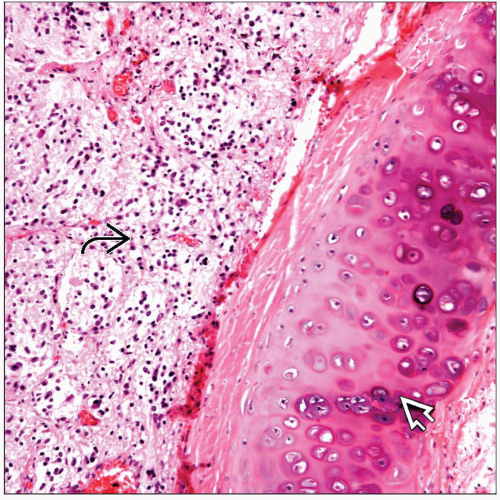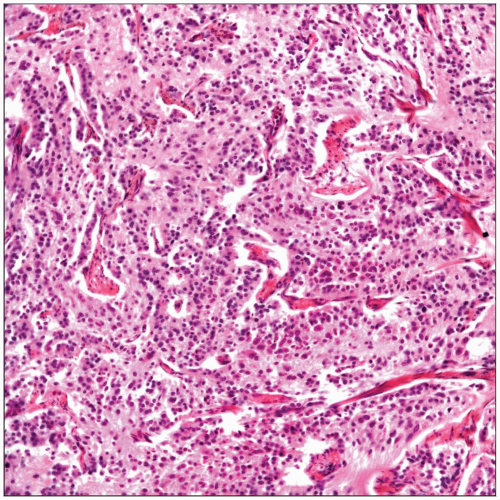Ganglioneuroblastoma
Key Facts
Terminology
P-GNB
Clinical Issues
Incidence
GNBs are exceedingly rare tumors in the lung
Cases described have been in adult patients
There is no gender predilection
Symptoms
Cough
Hypercalcemia
Gastric ulcers
Multiple endocrine neoplasia
Asymptomatic
Macroscopic Features
Intraparenchymal tumor
Peribronchial tumor impinging into bronchial lumen
Microscopic Pathology
Small cell proliferation
Neuropil
Larger cells with prominent nucleoli
Necrosis &/or hemorrhage
Top Differential Diagnoses
Small cell carcinoma
Carcinoma will display positive staining for keratin
Neuroendocrine carcinoma (carcinoid tumor)
GNB is negative for neuroendocrine markers
Rhabdomyosarcoma
GNB is negative for muscle markers
Melanoma
GNB is negative for mart-1 &/or HMB-45
TERMINOLOGY
Abbreviations
Pulmonary ganglioneuroblastoma (GNB)
Definitions
Malignant neoplasm of neural origin
ETIOLOGY/PATHOGENESIS
Etiology
Although etiology of these tumors is unknown, it is possible that they may arise from residual neural tissue in lung
CLINICAL ISSUES
Epidemiology
Incidence
GNBs are exceedingly rare tumors in lung
Age
Cases described have been in adults
Gender
No apparent gender predilection
Presentation
Cough
Multiple endocrine neoplasia (MEN)
Gastric ulcers
Hypercalcemia
Asymptomatic
Treatment
Surgical approaches
Lobectomy or pneumonectomy
Adjuvant therapy
Questionable additional therapy
Prognosis
Difficult to evaluate due to limited number of cases reported
MACROSCOPIC FEATURES
General Features
Well circumscribed
Tan to white
Homogeneous cut surface
Intraparenchymal tumor
Peribronchial tumor impinging into bronchial lumen
Size
Variable size from 1-5 cm in diameter
MICROSCOPIC PATHOLOGY
Histologic Features
Small cell proliferation
Neuropil
Nuclear atypia
Mitotic activity
Larger cells with prominent nucleoli
Cystic changes
Necrosis &/or hemorrhage
Predominant Pattern/Injury Type
Diffuse
Predominant Cell/Compartment Type
Nervous, neural
DIFFERENTIAL DIAGNOSIS
Small Cell Carcinoma
Carcinoma will display positive staining for keratin
Does not show the presence of neuropil
Ganglion differentiation is not present in small cell carcinomas
Stay updated, free articles. Join our Telegram channel

Full access? Get Clinical Tree






